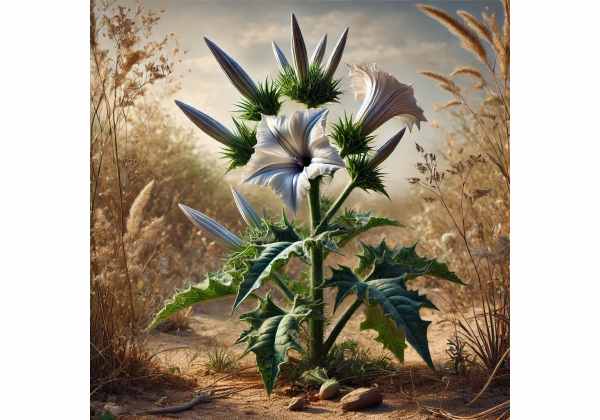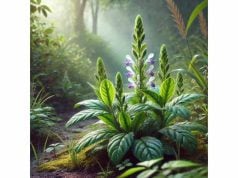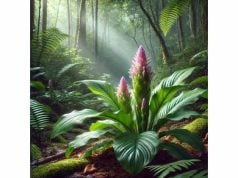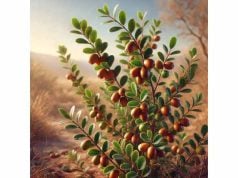
Jimsonweed, known scientifically as Datura stramonium, is a potent herb with a notorious reputation for its toxic and hallucinogenic properties. Traditionally used in various cultural rituals and folk medicines, this plant has a complex profile that includes both potential therapeutic applications and significant safety risks. Despite its historical usage for respiratory relief and antispasmodic properties, modern research emphasizes its dangerous side effects if misused. In this comprehensive article, we explore the botanical characteristics, phytochemical makeup, health-related attributes, and practical applications of jimsonweed, while highlighting critical safety guidelines and scientific insights that underscore its potent effects.
Table of Contents
- Plant Profile and Identification
- Phytochemical Composition and Active Compounds
- Health Benefits and Essential Properties
- Uses and Safety Guidelines
- Scientific Research and Key Studies
- Frequently Asked Questions
Plant Profile and Identification
Jimsonweed (Datura stramonium) is a fast-growing annual or biennial herbaceous plant that belongs to the Solanaceae family. It is native to temperate and subtropical regions worldwide and is often found in disturbed soils, roadsides, and abandoned fields. The plant can grow up to 1.5 meters tall, with a robust, erect stem covered in coarse hairs. Its large, trumpet-shaped flowers are typically white to purple with a distinct, spiky calyx, and they open at night, emitting a strong, musky odor. The fruit is a spiny capsule that splits open explosively to release numerous seeds—a natural mechanism for widespread dispersal.
Jimsonweed’s leaves are broad, ovate to triangular, with deeply lobed margins that give them a ragged appearance. The plant’s characteristic features—its showy, large flowers and thorny seed capsules—make it easily recognizable. Despite its attractive appearance, every part of jimsonweed contains potent alkaloids, making it one of the most toxic plants in the Solanaceae family.
Historically, indigenous peoples and traditional healers have used jimsonweed in controlled, ritualistic contexts. It has been employed for its antispasmodic, analgesic, and hallucinogenic properties in shamanic practices, although its unpredictable effects have also led to numerous cases of poisoning. Today, its cultivation is generally discouraged due to its high toxicity and potential for abuse, but it continues to be studied for its bioactive compounds and their pharmacological applications.
Modern botanical studies emphasize that while jimsonweed is sometimes mistaken for ornamental or medicinal plants, its toxicity cannot be overstated. Misidentification or improper use can lead to severe anticholinergic poisoning, characterized by symptoms such as dilated pupils, hallucinations, rapid heart rate, and even coma. Consequently, accurate identification is critical, and experts recommend extreme caution when handling this plant.
In summary, the botanical profile of jimsonweed—with its striking flowers, spiky seed capsules, and potent toxic alkaloids—underscores its dual nature as both a historically revered and dangerously potent herb. Its ease of growth in disturbed environments has contributed to its widespread distribution, yet its inherent toxicity remains a paramount concern in both traditional use and modern research.
Phytochemical Composition and Active Compounds
Jimsonweed’s biological activity is primarily due to its rich content of tropane alkaloids and other bioactive compounds. These substances, while responsible for some traditional therapeutic applications, also underlie the plant’s severe toxicity. The complex chemical profile of jimsonweed has been the subject of extensive phytochemical research, with the following compounds identified as key players:
- Atropine
Atropine is one of the principal tropane alkaloids found in jimsonweed. It acts as a competitive antagonist at muscarinic acetylcholine receptors, leading to anticholinergic effects such as dilated pupils, dry mouth, tachycardia, and blurred vision. While atropine has clinical uses in ophthalmology and as an antidote for certain poisonings, its presence in jimsonweed is a major contributor to the plant’s toxicity. - Scopolamine (Hyoscine)
Scopolamine is another potent tropane alkaloid present in jimsonweed. Known for its sedative and hallucinogenic properties, scopolamine can induce delirium and amnesia. In controlled doses, it has been used to prevent motion sickness, but in jimsonweed, it is responsible for dangerous central nervous system effects, including confusion, agitation, and in severe cases, coma. - Hyoscyamine
Hyoscyamine is closely related to atropine and scopolamine and contributes further to the anticholinergic syndrome associated with jimsonweed poisoning. It exerts similar effects by blocking acetylcholine receptors, leading to reduced secretions, increased heart rate, and severe cognitive impairment when ingested in toxic amounts. - Tropane Alkaloid Derivatives
Beyond the primary alkaloids, jimsonweed contains several minor tropane derivatives that synergize with atropine, scopolamine, and hyoscyamine. These compounds amplify the overall toxicity and contribute to the unpredictable pharmacological profile of the plant. Their exact concentrations can vary widely based on growing conditions and the plant’s maturity. - Flavonoids and Phenolic Compounds
In addition to alkaloids, jimsonweed contains flavonoids and phenolic compounds that offer antioxidant properties. While these compounds may provide some cellular protection against oxidative stress, their beneficial effects are overshadowed by the potent anticholinergic substances present in the plant. - Essential Oils
The volatile components of jimsonweed, including various terpenes, contribute to its characteristic odor. These essential oils may exhibit mild antimicrobial and anti-inflammatory effects, but they are not sufficient to mitigate the plant’s overall toxicity.
The interplay of these bioactive compounds defines jimsonweed’s complex pharmacological profile. In controlled medical settings, isolated tropane alkaloids have therapeutic applications; however, in jimsonweed, the natural combination of these substances poses significant health risks. The variability in alkaloid concentration between different plants and even among different parts of the same plant further complicates its use and contributes to the high incidence of accidental poisoning.
Modern analytical methods, including HPLC and GC-MS, have enabled researchers to quantify these compounds and understand their synergistic actions. This detailed phytochemical analysis is crucial for developing potential antidotes and for the forensic analysis of jimsonweed poisoning cases. However, despite advances in research, the inherent toxicity of jimsonweed makes it a plant that should be approached with extreme caution.
In summary, the phytochemical composition of jimsonweed—dominated by potent tropane alkaloids such as atropine, scopolamine, and hyoscyamine—explains both its historical use as a hallucinogen and its dangerous toxicity. While other compounds in the plant offer some antioxidant and antimicrobial effects, the overwhelming presence of anticholinergic substances renders jimsonweed a highly hazardous herb.
Health Benefits and Essential Properties
While jimsonweed is infamous for its toxicity, it has also been used traditionally for various medicinal purposes under controlled conditions. It is critical to note that any potential health benefits of jimsonweed are accompanied by severe risks, and its use is not recommended without expert supervision. Historically, the herb has been associated with several therapeutic properties, though modern medical consensus strongly cautions against its use due to its high toxicity.
Historical Therapeutic Uses
In traditional medicine, jimsonweed was sometimes used in very small, carefully controlled doses for its antispasmodic and bronchodilator effects. Folk remedies included:
- Respiratory Relief: Some traditional healers used jimsonweed extracts to relieve asthma and bronchitis symptoms by dilating the airways. This effect is attributed to the anticholinergic activity of its alkaloids.
- Antispasmodic Applications: The herb was occasionally used to alleviate muscle spasms and cramps, though the narrow therapeutic window made such treatments highly risky.
- Psychedelic and Ritualistic Use: In certain cultural rituals, jimsonweed was used to induce altered states of consciousness. Its hallucinogenic properties were considered a means to access spiritual realms, though such practices were fraught with danger due to unpredictable dosing.
Potential Health Benefits in Modern Research
Some modern studies have revisited the active compounds of jimsonweed for their pharmacological properties, yet these investigations are largely confined to controlled laboratory settings. Potential benefits observed include:
- Anticholinergic Effects: While primarily responsible for toxicity, the anticholinergic properties of jimsonweed alkaloids can, in controlled doses, reduce salivation and bronchial secretions. This has limited clinical applications in specific medical emergencies.
- Analgesic and Sedative Effects: Some research suggests that, in isolated forms, certain alkaloids may offer pain-relieving and sedative effects. However, the risk of cognitive impairment and delirium far outweighs these potential benefits.
- Anti-inflammatory and Antioxidant Activity: The presence of minor flavonoids and phenolic compounds in jimsonweed indicates that there may be some anti-inflammatory and antioxidant effects. Nonetheless, these are insufficient to counterbalance the toxicity of the major alkaloids.
Risk-Benefit Analysis
It is important to stress that any potential health benefits of jimsonweed are largely theoretical or observed under rigorous laboratory conditions. In practical, clinical, or self-administered contexts, the risks associated with jimsonweed far exceed any possible benefits. The narrow margin between a therapeutic dose and a toxic dose makes it a perilous choice for medicinal use. Overdose can result in severe anticholinergic poisoning, leading to hallucinations, rapid heart rate, hyperthermia, and even death.
Modern Medical Perspective
Contemporary medicine generally categorizes jimsonweed as a toxic plant with very limited, if any, legitimate therapeutic applications. Research into its active compounds is primarily aimed at understanding its toxic mechanisms to improve treatment for poisoning rather than promoting its use as a medicine. Because of its unpredictable potency and the serious side effects associated with its use, jimsonweed is not recommended for self-treatment or unsupervised use.
In summary, while jimsonweed has been historically used for a range of medicinal purposes, its severe toxicity renders it a high-risk herb with limited practical benefits. Modern research acknowledges some pharmacological activities but underscores that the dangerous side effects and narrow therapeutic index preclude its safe use. The focus in contemporary studies is on developing effective treatments for jimsonweed poisoning rather than harnessing its traditional applications.
Uses and Safety Guidelines
Given its potent chemical makeup, jimsonweed is predominantly recognized for its risks rather than its benefits. Despite historical uses in traditional medicine and ritualistic contexts, its modern application is overwhelmingly cautioned against. Below, we outline the few contexts in which jimsonweed has been used, along with stringent safety guidelines that emphasize the importance of avoiding unsupervised use.
Traditional Uses
- Ritualistic and Shamanic Practices:
In some indigenous cultures, jimsonweed has been used in very controlled, ritualistic settings to induce hallucinogenic experiences. Such practices were performed by experienced shamans who understood the precise dosages required, though even then, the risks were substantial. - Historical Medicinal Uses:
Traditionally, small doses of jimsonweed were occasionally used to treat respiratory conditions such as asthma due to its bronchodilatory effects. It was also used as an antispasmodic to relieve muscle cramps. However, these applications were fraught with danger and were never standardized.
Modern Applications: A Cautionary Note
- Forensic and Toxicology Studies:
Today, jimsonweed is primarily studied in forensic toxicology to better understand its mechanisms of poisoning and to develop effective antidotes. It is not recommended for any medicinal or culinary use outside of strictly controlled research environments. - Pharmacological Research:
The isolated alkaloids from jimsonweed, such as atropine and scopolamine, have well-documented therapeutic applications in medicine when used in purified, regulated forms. These compounds are administered in controlled doses for specific clinical purposes (e.g., to treat bradycardia or as an antidote for nerve agent poisoning). However, the crude consumption of jimsonweed is dangerous.
Safety Guidelines
- Do Not Self-Medicate:
Jimsonweed should never be used for self-treatment. The plant’s toxic dose is very close to any dose that might produce a desired effect, making it extremely hazardous without medical supervision. - Strict Supervision:
If, in a very rare circumstance, jimsonweed or its compounds are used for clinical purposes, it must be under strict medical supervision in a controlled environment, using pharmaceutical-grade preparations. - Avoid Ingestion:
Ingesting any part of the jimsonweed plant is highly dangerous. Symptoms of poisoning include severe anticholinergic effects such as dilated pupils, hallucinations, dry mouth, rapid heartbeat, hyperthermia, and in severe cases, coma or death. - Handling Precautions:
While handling the plant, use gloves and avoid ingestion of any plant material. Even inhaling dust from dried plant matter can be hazardous. - Educate and Inform:
Healthcare providers and educators should be informed about the risks associated with jimsonweed to prevent accidental ingestion and to ensure prompt treatment in cases of poisoning.
Practical Tips for Avoidance
- Identification:
Learn to accurately identify jimsonweed in the wild. Its large, trumpet-shaped flowers, spiny seed capsules, and distinctive odor are key markers. If you are unsure of a plant’s identity, do not handle it. - Storage and Disposal:
If jimsonweed is encountered, especially in areas accessible to children or pets, it should be removed and disposed of safely to prevent accidental poisoning. - Community Awareness:
Public health campaigns in regions where jimsonweed grows wild can help raise awareness about its dangers, reducing the risk of accidental ingestion or misuse.
In conclusion, due to its potent toxic constituents, jimsonweed is a plant that should be approached with extreme caution. While its historical uses in traditional medicine and shamanic rituals are documented, the significant risks associated with its consumption far outweigh any potential benefits. Modern medicine emphasizes the dangers of unsupervised use, and strict safety protocols must be followed to avoid potentially fatal poisoning.
Scientific Research and Key Studies
Scientific research into jimsonweed has focused predominantly on understanding its toxicological profile, as well as exploring its pharmacological properties in controlled laboratory settings. Here are some key studies that illustrate the current state of research on this notorious herb:
- Toxicological Mechanisms and Clinical Manifestations (2009)
A comprehensive review published in the Journal of Medical Toxicology analyzed numerous cases of jimsonweed poisoning. The study detailed the clinical manifestations of anticholinergic syndrome induced by jimsonweed and highlighted the challenges in treating such poisoning due to the variability in alkaloid concentrations. The review underscored the importance of early recognition and aggressive supportive care in cases of overdose. - Pharmacokinetics of Tropane Alkaloids (2011)
Research published in Clinical Pharmacokinetics investigated the absorption, distribution, metabolism, and excretion of the primary tropane alkaloids found in jimsonweed, including atropine, scopolamine, and hyoscyamine. The study provided valuable insights into how these compounds interact within the human body and established critical dose-response relationships that are used in clinical settings for therapeutic purposes—when isolated and purified. - Therapeutic Potential of Isolated Alkaloids (2013)
A study in Phytotherapy Research explored the therapeutic applications of isolated jimsonweed alkaloids in controlled, clinical environments. The research demonstrated that, in regulated doses, these compounds can be used safely for specific medical indications, such as in the treatment of bradycardia and as an antidote in organophosphate poisoning. However, the study also reinforced that crude plant extracts remain too dangerous for any therapeutic use. - Neuropharmacological Effects and Hallucinogenic Properties (2015)
An investigation published in Frontiers in Pharmacology examined the neuropharmacological effects of jimsonweed extracts in animal models. The study observed significant central nervous system depression and hallucinogenic effects attributable to its tropane alkaloids. The findings provide a scientific basis for the historical use of jimsonweed in shamanic practices but also highlight the high risk of adverse outcomes. - Anticholinergic Toxicity Case Studies (2018)
Several case studies compiled in Toxicology Reports documented the outcomes of accidental jimsonweed ingestion. These studies served as a critical resource for emergency physicians by outlining effective management strategies, including the use of physostigmine as an antidote in severe cases of anticholinergic toxicity. The case reports underscore the need for public education regarding the dangers of jimsonweed.
Overall, the scientific literature on jimsonweed emphasizes its dual nature: while its isolated compounds have potential clinical applications when used under strict medical supervision, the plant as a whole is extremely dangerous due to its unpredictable potency and narrow therapeutic index. Ongoing research aims to refine the understanding of its toxicokinetics and to develop improved treatment protocols for poisoning, rather than promoting its use as a therapeutic agent.
Frequently Asked Questions
What is jimsonweed and why is it dangerous?
Jimsonweed (Datura stramonium) is a toxic herb known for its hallucinogenic and anticholinergic effects. It contains potent tropane alkaloids that can cause severe poisoning, leading to symptoms like delirium, rapid heart rate, and potentially fatal respiratory failure.
Has jimsonweed ever been used for medicinal purposes?
Historically, jimsonweed was used in controlled, ritualistic settings for its antispasmodic and bronchodilator properties. However, due to its high toxicity and unpredictable effects, modern medicine strongly advises against its use outside of strictly controlled clinical environments.
What are the key active compounds in jimsonweed?
The main active compounds in jimsonweed are tropane alkaloids, including atropine, scopolamine, and hyoscyamine. These compounds are responsible for its anticholinergic and hallucinogenic properties and are the primary cause of its toxicity.
Can jimsonweed ever be used safely?
When isolated and purified under strict medical supervision, some of jimsonweed’s alkaloids have therapeutic uses. However, consuming the whole plant or crude extracts is extremely dangerous and can lead to severe poisoning or death.
What should I do if someone is poisoned by jimsonweed?
Immediate medical attention is crucial in cases of jimsonweed poisoning. Do not attempt to treat the condition at home. Emergency treatments may include activated charcoal, supportive care, and the administration of antidotes like physostigmine under professional supervision.
Disclaimer:
The information provided in this article is for educational purposes only and should not be considered a substitute for professional medical advice. Jimsonweed is an extremely toxic plant, and any handling or use should be done only under strict medical supervision. Always consult a qualified healthcare provider before making any decisions regarding its use.
We encourage you to share this article on Facebook, X (formerly Twitter), or your preferred social media platforms. Follow us on social media for more insights into natural health remedies and wellness tips!










